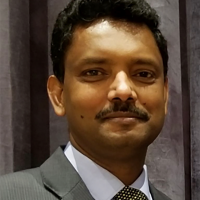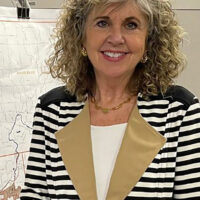Ven Tadikonda, an entrepreneur and technologist, and Loren Matthes, a retired municipal financial advisor, are running for the Carmel City Council’s West District seat in the May 2 Republican primary. The winner will face Democrat Anita Joshi in the general election in November.
Both candidates have lived in Carmel approximately 20 years, and neither has previously held elected office. They answered the following questions from Current:


Carmel is often criticized for its debt load. Do you believe Carmel has too much debt? Why or why not?
Tadikonda: An equilibrium approach to estimate incidence effects on both the sources and uses of income will help us handle the debt load. Investing into community growth is good for the City of Carmel, however fiscal transparency and controls on cost overruns are mandatory. A developer-backed bond might clear overhead on taxpayers, however the pace and location of development – ignoring neighborhood needs – is a growing concern. An inclusive growth balancing the ecosystem and economic security is mandatory!
Matthes: Carmel’s annual operating costs are covered with its annual operating budget such as city personnel, public safety and street maintenance. The city correctly uses long term debt to finance long term capital improvements such as infrastructure (roads, sewer, water and drainage), parking facilities and public buildings. Carmel’s debt is rated “AA” by Standard and Poors, which means the obligor has very strong capacity to meet its financial commitments. When all economic and financial categories are measured, Carmel’s financial condition is rated very strong. In the future, the city must work to ensure that future obligations are analyzed and handled in a responsible way to continue to protect taxpayers while responsibly balancing the city’s needs and finances.
How should the city balance redevelopment with maintaining the character of surrounding, well-established areas?
Tadikonda: Our current development of three- or five-story buildings and other commercial developments all at the core of Carmel downtown are outweighing the advantages of otherwise ponds/clean and green landscapes with trees. This will turn our downtown into a concrete jungle with flooding, sound pollution and other issues. Distributed development with a balance of clean and green environment is what we need to focus on in the next couple of years. Having lived 50 percent of my life in multi-tenant apartments in the U.S. and other countries, I can see the challenges of our city in the next five to 10 years. Exploitation of natural resources in a blind pursuit of development will aggravate the situation and may lead to ecological imbalance and economic insecurity.
Matthes: As a city, we have prioritized having the best trails, parks and events for the people of Carmel. With many of these amenities, walkability and density are necessary to make and keep them viable. I think that both younger and older generations enjoy the option to get from one place to another by biking or walking. Density should be approached strategically and carefully considered. We can continue to build upon activation areas like Midtown, the Arts District and the Meridian Corridor while maintaining residential feel in the community outside the central core.
The city has devoted 1 percent of its general fund to supporting local arts. Is this an appropriate amount and funding source? Why or why not?
Tadikonda: Promoting sports and arts improves the quality of life. Social media and a range of exhibits and programs involving schools, international communities and neighborhoods within and outside the City of Carmel helps it grow multitude. A well-articulated marketing strategy with support from various businesses, diverse communities and City government will support and promote and fund arts in Carmel.
Matthes: The arts are an expression of beauty and creativity that can be appreciated by people of all ages and are important to the culture of the community. I am supportive of spending a portion of the city’s budget on supporting local arts organizations but want to ensure that money is used to enhance the groups’ revenue and private fundraising, and not become the sole source of financing.
The city has had a couple of failed starts in implementing diversity training and initiatives. How do you think the city should handle diversity training?
Tadikonda: Enroll and engage the communities in each district. Identify and promote them at district and city level. Initiate diversity and inclusive social events outside Carmel downtown. Educate and promote sports, religious events, international fest events, etc. Recognize, respect and celebrate the indigenous traditions.
Matthes: Carmel should focus on identifying areas where issues exist, hire qualified individuals who are experienced in how to properly train city employees on how to handle those issues and integrate the training into the established human resources processes for the city.
What should be the city’s role in supporting its senior citizen residents and their needs?
Tadikonda: Family means no one gets left behind or forgotten. Allocate 80|20 rules (at least 80 percent of units occupied by at least one person 55 or older) for housing with low cost or no maintenance. Community care, infrastructure, proximity for services and community involvement will support our senior citizen residents.
Matthes: Carmel should continue to provide top quality amenities, such as parks, trails, recreation and performing arts, that promote activity and engagement with the senior community. The city should look to partner with groups who are providing senior services and find opportunities where those services can be appropriately enhanced. There also need to be more options available for those who are looking for lower price-point housing as their needs change later in life.
What is Carmel doing well? What is its area in need of most improvement?
Tadikonda:
What Carmel is doing well:
-Vibrant communities with clean, green and safe neighborhoods
-Schools that promote academic excellence with fine arts and sports.
-Infrastructure and services that support and promote quality of life
An area for improvement is inclusive growth with due attention to celebrating heritage and traditions of diverse communities. Inclusive growth for Carmel is the one in which different social groups mix and have equal opportunities to participate fairly across society and creates opportunities for all age groups.
Matthes: Carmel has worked hard to encourage high quality growth and development in the central core as well as strong public safety services and outstanding infrastructure throughout the city. Carmel has provided amenities and opportunities that appeal to a variety of residents and provide a high quality of life.
I do feel that as Carmel continues to mature, the city needs to be more strategic on development projects, especially where they should be located. Carmel needs to preserve the residential and family feel of its neighborhoods, and provide better communication and education about the financial status of the city.




